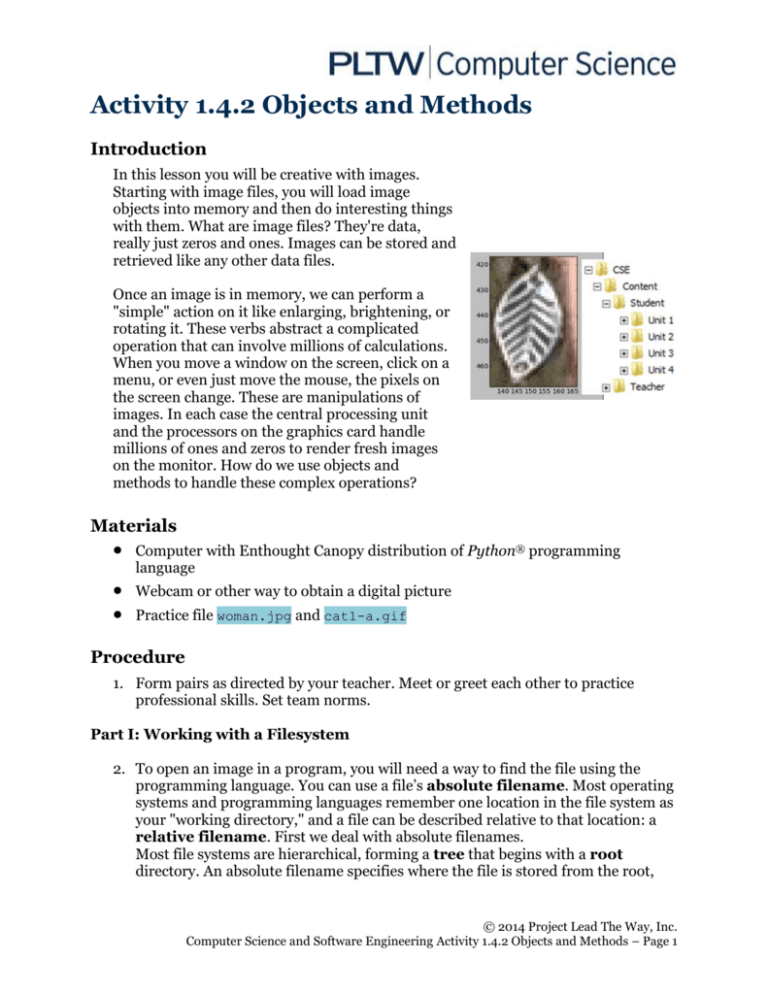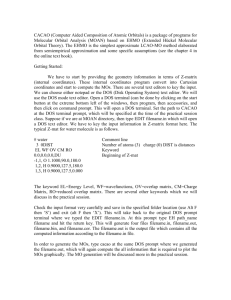1.4.2.A ObjectsAndMethods
advertisement

Activity 1.4.2 Objects and Methods
Introduction
In this lesson you will be creative with images.
Starting with image files, you will load image
objects into memory and then do interesting things
with them. What are image files? They're data,
really just zeros and ones. Images can be stored and
retrieved like any other data files.
Once an image is in memory, we can perform a
"simple" action on it like enlarging, brightening, or
rotating it. These verbs abstract a complicated
operation that can involve millions of calculations.
When you move a window on the screen, click on a
menu, or even just move the mouse, the pixels on
the screen change. These are manipulations of
images. In each case the central processing unit
and the processors on the graphics card handle
millions of ones and zeros to render fresh images
on the monitor. How do we use objects and
methods to handle these complex operations?
Materials
Computer with Enthought Canopy distribution of Python® programming
language
Webcam or other way to obtain a digital picture
Practice file woman.jpg and cat1-a.gif
Procedure
1. Form pairs as directed by your teacher. Meet or greet each other to practice
professional skills. Set team norms.
Part I: Working with a Filesystem
2. To open an image in a program, you will need a way to find the file using the
programming language. You can use a file’s absolute filename. Most operating
systems and programming languages remember one location in the file system as
your "working directory," and a file can be described relative to that location: a
relative filename. First we deal with absolute filenames.
Most file systems are hierarchical, forming a tree that begins with a root
directory. An absolute filename specifies where the file is stored from the root,
© 2014 Project Lead The Way, Inc.
Computer Science and Software Engineering Activity 1.4.2 Objects and Methods – Page 1
which is typically indicated by / in UNIX and Max Operating Systems and by the
startup drive letter in Windows, such as C:\.
Files and directories are nodes, each branching from one parent in the tree,
with the root considered the “top” of the tree. The absolute filename of admin (in
the green box below) is C:/Users/admin. What is the absolute filename of
nice.jpg (in the red circle below)?
3. A filename can be specified with a relative filename. A relative name means
that the file location is described starting from the current working directory. It
does not begin with the root / or C:\. The special symbol of two periods .. is
used by many languages to represent "up one level in the tree."
If we were currently working in the admin directory, what would be the relative
filename for nice.jpg?
4. The table below lists the commands from UNIX for navigating the tree. Even
when you run a Python environment on Windows or another operating system,
Python will recognize these UNIX commands.
Command
Purpose
pwd
Print working directory.
cd
Change directory. By itself, it means change to the user’s
home directory.
cd ..
Move one level up toward the root. The double dot is an
abbreviation for the directory above the current one.
cd dirname
Move downward in the tree into directory dirname.
ls
List all files and directories in the current directory.
© 2014 Project Lead The Way, Inc.
Computer Science and Software Engineering Activity 1.4.2 Objects and Methods – Page 2
Try to navigate up the tree and back down into a different directory using these
commands in the iPython shell. The iPython session below is an example. Your
output will be different, and you will have to tailor your input to match the output
in order to navigate up the filesystem.
In []: pwd
Out[]: u’C:\\Windows\\system’
In []: cd ..
C:\Windows
In []: ls
Volume in drive C is Win7Disk
Volume Serial Number is 1A7E-10ED
Directory of C:\Windows
05/07/2013 10:36 AM
<DIR>
05/07/2013 10:36 AM
<DIR>
11/20/2010 04:29 PM
07/13/2009 11:52 PM
<DIR>
.
..
65,024 bfsvc.exe
Cursors
In []: cd Cursors
C:\Windows\Cursors
5. You may have noticed the double backslashes in the output shown above from
pwd. The double backslashes are an escape character. Escape characters are
multi-character codes that allow you type single characters that would be invisible
or would have other effects. Quotation marks can be included inside a quoted
string, for example:
'This entire quote \' has a single quotation mark in the
middle but no backslash!'
A few common escape characters are shown in the following table:
Escape sequence
\t
\n
\\
\'
\"
Character
Tab
Newline
Backslash
Single quotation mark
Double quotation mark
How would you name the file C:\Windows\Cursors\cursor1.png using escape
characters for the backslashes?
Is this an absolute filename or a relative filename? Do you have to be in a
particular working directory for this filename to make sense?
Part II: Rendering an Image on Screen
6. Launch Canopy. Open an editor window. Set the working directory to your folder.
Create a new Python file. Save the file as JDoe_JSmith_1_4_2.py.
© 2014 Project Lead The Way, Inc.
Computer Science and Software Engineering Activity 1.4.2 Objects and Methods – Page 3
7. Lines 12 and 14 of the code below create an absolute filename for an image by
assuming that the image is in the same folder as your Python script. Use
Windows Explorer to place files woman.jpg and 'cat-1a.gif' in the folder
where you are saving Python scripts.
Earlier we used the code editor to define functions that we still executed in the
iPython session. Coding in the code editor will execute directly with the “play”
button” if it is not in a function definition. Execute the following code.
1
2
3
4
5
6
7
8
9
10
11
12
13
14
15
16
17
18
19
20
21
22
'''
JDoe_JSmith_1_4_2: Read and show an image.
'''
import matplotlib.pyplot as plt
import os.path
import numpy as np
# “as” lets us use standard abbreviations
'''Read the image data'''
# Get the directory of this python script
directory = os.path.dirname(os.path.abspath(__file__))
# Build an absolute filename from directory + filename
filename = os.path.join(directory, 'woman.jpg')
# Read the image data into an array
img = plt.imread(filename)
'''Show the image data'''
# Create figure with 1 subplot
fig, ax = plt.subplots(1, 1)
# Show the image data in a subplot
ax.imshow(img, interpolation='none')
# Show the figure on the screen
fig.show()
You should see a new window displaying the image of a woman, perhaps hidden
behind other windows. You can use Alt-tab to cycle through windows.
The figures created by matplotlib are interactive graphical
user interfaces (GUIs). The GUI shows the coordinates of
the mouse pointer, as shown at right. These coordinates are
the image coordinates, more or less. (That's not quite true,
since the coordinates shown by the GUI can be between
integers, unlike the image coordinates. Also, we could have
placed the image with its upper left corner somewhere other
than (0, 0).)
a. What is the (x, y) coordinate pair of the woman’s nose
in the image coordinate system?
b. Change the code so that it shows the cat. What are the
image coordinates at the tip of the cat's nose?
© 2014 Project Lead The Way, Inc.
Computer Science and Software Engineering Activity 1.4.2 Objects and Methods – Page 4
Part III: Objects and Methods
8. Consider lines 16-22 of the code from the previous step.
a. A class is a category of objects that have properties (a set of variables with
potentially unique values for each object) and methods (a common set of
scripts that do things). An object is an instance of its class.
In line 18, plt.subplots(1, 1) creates a 1 x 1 grid of subplots in a figure. It
returns a 2-tuple. The first element of the tuple is an object in the class Figure.
The second element of the tuple is an object in the class AxesSubplot.
The particular Figure object is being stored in a new variable, fig. The
particular AxesSubplot object is being stored in the variable ax.
That was a lot of information! fig and ax are both objects. What class is each
of them in?
fig is an instance of the class _________________
ax is an instance of the class __________________
b. In line 20 a method is being called on the object ax.
The method is imshow(). It is being given 1 argument: img. The imshow()
method is being called on the ax object. Since ax is an instance of the
AxesSubplot class, imshow() must be a method of the AxesSubplot class.
Similarly, in line 22, the method _______ is being called on the object
________. That method is being given ___ arguments. That method is a
method of the class _________.
c. Comments help us undestand why a method is being called. Which comments
explain which lines in the code above?
© 2014 Project Lead The Way, Inc.
Computer Science and Software Engineering Activity 1.4.2 Objects and Methods – Page 5
Part IV: Arrays of Objects
9. Methods often return data. Calling subplots(1, 1) returns a tuple of two
objects:
(Figure, AxesSubplot)
The method subplots can also be used to create a grid of AxesSubplots, as shown
below. In this case subplots (1, n) will return
(Figure, ndarray of AxesSubplots)
where ndarray is an n-d array, short for an "n-dimensional array." You can access
the elements of an ndarray with an index in square brackets:
17
18
19
20
21
22
23
24
# Create a 1x2 grid of subplots
# fig is the Figure, and ax is an ndarray of AxesSubplots
# ax[0] and ax[1] are the two Axes Subplots
fig, ax = plt.subplots(1, 2)
# Show the image data in the first subplot
ax[0].imshow(img, interpolation='none')
# Show the figure on the screen
fig.show()
a. Modify lines 18 and 20 of your code to match what is shown above. You will
have to re-execute the code to see the effect. Practice using object-oriented
syntax by describing line 22: the method _______ is being called on the
object ________.
b. Modify the code provided above to create the following figures:
i.
An image of the woman in both of the subplots.
ii.
Iterated images of a picture:
© 2014 Project Lead The Way, Inc.
Computer Science and Software Engineering Activity 1.4.2 Objects and Methods – Page 6
Part V: Keyword = Value Pairs
10. Methods and other functions often can be called with additional arguments. If
you don't provide an optional argument when you call the function, the default
value of that argument is used.
The imshow() method was called on both of the AxesSuplots shown below. For
the axes on the left, the method was called with interpolation='none',
whereas the axes on the right used the default value of the interpolation
argument.
08
09
10
11
12
13
14
15
16
17
18
19
20
21
22
23
24
25
26
'''Read the image data'''
# Get the directory of this python script
directory = os.path.dirname(os.path.abspath(__file__))
# Build an absolute filename from directory + filename
filename = os.path.join(directory, 'woman.jpg')
# Read the image data into an array
img = plt.imread(filename)
# Create figure with 2 subplots
fig, ax = plt.subplots(1, 2)
# Show the image data in the first subplot
ax[0].imshow(img)
ax[1].imshow(img, interpolation='none') # Override the default
ax[0].set_xlim(135, 165)
ax[0].set_ylim(470, 420)
ax[1].set_xlim(135, 165)
ax[1].set_ylim(470, 420)
# Show the figure on the screen
fig.show()
The matplotlib interface will normally interpolate between values of the
image pixels, inferring intermediate colors for screen pixels between the
centers of image pixels.
The keywords of a function are often important ideas from the library's
subject matter. Interpolating is an important idea in math. Describe the
connections among interpolation between data points, the interpolation
argument, the image above, and the code above.
© 2014 Project Lead The Way, Inc.
Computer Science and Software Engineering Activity 1.4.2 Objects and Methods – Page 7
11. An API (Application Programming Interface) for a class describes all
methods you can call on objects in the class. Here are some of the methods from
the API for AxesSubplot.
Some methods of
Description
plt.SubplotAxes
axis('on' | 'off')
Show/hide axes (and their titles and ticks)
set_xlim(xmin,xmax)
set_ylim(ymin,ymax)
cla()
imshow(img)
minorticks_on()
minorticks_off()
set_xlabel(string)
set_ylabel(str)
set_xticks(list)
set_title(string)
Documentation uses a vertical line | for “or”,
showing that you can either 'on' or 'off'
Set lower and upper limits to x-axis
Set lower and upper limits to y-axis
Clear axes
Place an image on an axis
Show minor ticks
Hide minor ticks
Set x-axis title
Set y-axis title
Set major ticks to label
Set subplot title
a. Experiment in iPython until you succeed in calling a couple of these methods
on an AxesSubplot. After an object.method() call, you can view the
updated figure with its canvas' draw() method.
Use fig.canvas.draw() after a change in an AxesSubplot
In []: ax[0].imshow(img)
In []: fig.canvas.draw()
Reminder: You can use the up arrow to avoid having to retype the draw()
command each time.
b. Use the methods above to create three close-ups of an image in a single
Figure. Each close-up should show a 10 pixel by 10 pixel region. An example
using cat1-a.gif is shown here.
Share your work for this step as directed by your instructor, perhaps by
showing the teacher your image on screen and by submitting a ZIP file of:
the original image
a captured image of the Figure as shown above
© 2014 Project Lead The Way, Inc.
Computer Science and Software Engineering Activity 1.4.2 Objects and Methods – Page 8
your Python code
12. The ability to wade through documentation full of unknown terms is an important
skill. Go to the documentation at
http://matplotlib.org/api/axes_api.html#matplotlib.axes.Axes.imshow. This
documentation is for the class Axes, which includes the AxesSubplot subclass.
The link provided here points to the documentation for the imshow() method.
From the documentation, identify one additional method of an AxesSubplot .
Describe at least one of the optional arguments of that method and state its
default value.
13. The class AxesSubplot has many methods for displaying data, including the
plot() method.
plot(x, y, 'ro') places red circles (coded by 'ro') at all points (xi, yi) where
x and y are lists of the xi and yi coordinates, respectively. In an image containing
a few faces, mark the eyes with red circles using plot().
Share your work for this step as directed by your instructor, perhaps by showing
the teacher your image on screen and by submitting a ZIP file of:
the original image
a captured image of the Figure
your Python code
Conclusion
1. Describe similarities and differences between absolute filenames and relative
filenames.
2. What is an object?
3. Objects have methods and properties. What are methods and properties?
4. What happens when you call a method on an object?
© 2014 Project Lead The Way, Inc.
Computer Science and Software Engineering Activity 1.4.2 Objects and Methods – Page 9







